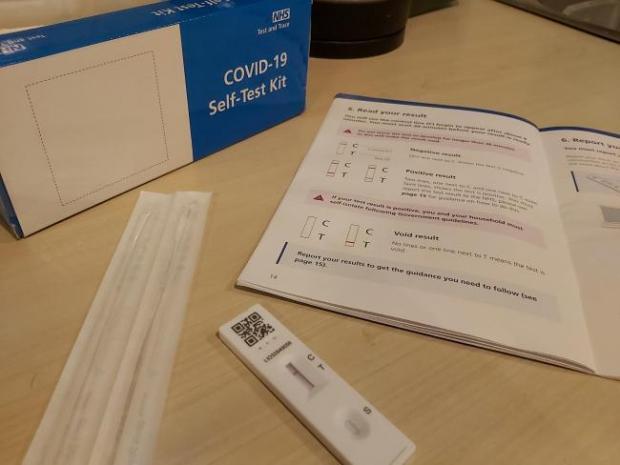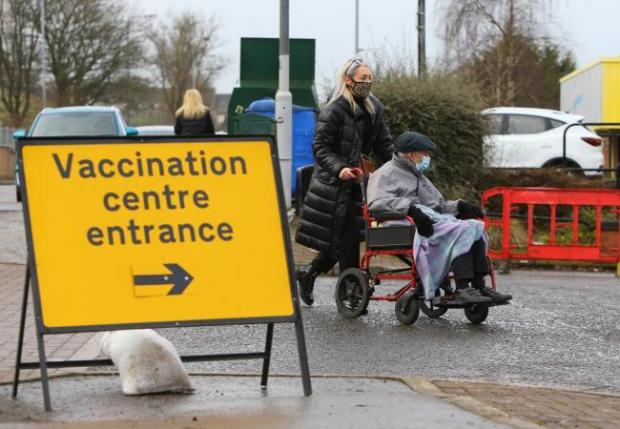Scots Covid expert: ‘Maximise’ protections for vulnerable to avoid future lockdowns
THE next phase of the pandemic must pivot away from population-wide restrictions in favour or “targeted protection measures for the most vulnerable”, according to an expert in public health and epidemiology.
Professor Helen Colhoun said maximising the use of lateral flow tests to and rapidly distributing antiviral drugs to patients most at risk of hospitalisation will be vital tools in steering the country back to normality while protecting the NHS.
Prof Colhoun also called for initiatives such as income support for workers who share a household with someone previously on the shielding list, to enable them to stay at home during periods when virus transmission is dangerously high.
 By December 14, 4,217 positive tests a day were being submitted for testing. During the September Delta wave, the peak was 6,397 per day
By December 14, 4,217 positive tests a day were being submitted for testing. During the September Delta wave, the peak was 6,397 per day
She said: “People have said at various points ‘we can’t possibly protect those who are shielding completely’ – well, that may be true, but can we do better than we are at the moment? Yes, I think we can.
“When we looked at what had happened to the population who had been on the shielding list and what were the determinants of acquisition of [Covid], you could clearly see that some of that was multiple occupancy households where co-habitees were in jobs with multiple interactions with the public.
“So it’s not just support for the person shielding that we should consider – there is a good case sometimes to consider income support for co-habitees to enable them to stay home during times of really high transmission.”
Prof Colhoun, an honourary consultant in public health at NHS Fife and chair of Medical Informatics and Life Course Epidemiology at Edinburgh University, has co-chaired the Covid-19 Modelling & Research cell at Public Health Scotland.
However, she was speaking to the Herald on Sunday for the first time in a personal capacity to put forward what she hopes is a “more positive” vision of route out of the Covid crisis.
READ MORE: If thousands are still unvaccinated – is it time to reframe what we mean by ‘protecting the herd’?
Prof Colhoun stressed that the booster programme is “very important”, but that she would like to see the benefit of lateral flow tests hammered home to the public much more.
She said: “The last time I analysed the figures, around a month ago, of the people who are doubly-vaccinated but end up in hospital, 85 per cent were people either on the shielding list or with known co-morbidities.
“If we really want to tackle hospitalisation as a major concern, it’s very clear to me that we really need to focus very strongly on targeted protection measures for the most vulnerable and, absolutely, one of the key interventions is a greater awareness of the usefulness and need for lateral flow testing.
“A lot of people still aren’t sure what lateral flow tests do and what they tell you. But basically, if you have virus in your nose to levels that are likely to cause transmission to others, the lateral flow tests are 99.5% sensitive at picking that up. They are very, very useful indeed.
“We should do everything we can to maximise people using lateral flow testing sensibly to maintain freedoms while protecting the vulnerable – that is absolutely critical.”
 Prof Colhoun said use of lateral flow kits should be maximised and their benefits hammered home to the public
Prof Colhoun said use of lateral flow kits should be maximised and their benefits hammered home to the public
Recent evidence on vaccine efficacy against Omicron has indicated significantly reduced protection against infection from two doses compared with the previous Delta strain, undermining the reliability of Covid certificates which allow entry into nightclubs and large events based on people being doubly-vaccinated.
Asked whether Covid certificates should be adapted to ‘negative test only’ and expanded to settings such as bars and restaurants in order to keep hospitality open safely and at normal capacity, Prof Colhoun said this was “difficult”.
Ideally, she said, customers should take the test at the door to prevent cheating (that is, logging a negative result in advance despite actually testing positive) and because an infected person can go from negative to positive – and infectious – within hours.
However, as lateral flows take around 15 minutes to deliver an accurate result, she concedes that this could lead to entranceway bottlenecks.
“If you don’t do them there and then people can cheat – but I think we also need to trust the population more,” said Prof Colhoun.
“If the population understand something, and they trust it, they will behave sensibly. Not every single person, but the vast majority will.
“If you explain to them that there is a mechanism [LFT] by which they can still have fun but protect the vulnerable, I think they would be very compliant with that.”
 Advice against socialising in the run up to Christmas has left bars and restaurants facing a raft of cancellations during the peak trading time of the year
Advice against socialising in the run up to Christmas has left bars and restaurants facing a raft of cancellations during the peak trading time of the year
Apart from boosters and LFTs, a third crucial weapon against Omicron must be rapid deployment of new drugs to prevent the people most at risk of a Covid hospitalisation from ever becoming that sick.
Sotrovimab – a monoclonal antibody infusion approved by UK regulators just two weeks ago – prevents the virus from replicating in the body and was found to cut the risk of hospitalisation and death by 79% in high-risk adults with symptomatic Covid infection.
Molnupiravir, a take-at-home antiviral pill, was also authorised in November for use in patients with mild to moderate Covid and who have at least one risk factor for severe disease – such as obesity, being over 60, diabetes, or heart disease.
In both cases, the medicine should be taken as soon as possible following a positive Covid test, and no later than five days from symptom onset.
READ MORE: Health board suspends orthopaedic surgery until February amid ‘significant pressure’ on beds
“These are drugs for use in the community for people who are very vulnerable, so the whole timeline for how you get those drugs to the infected person quickly is very important indeed,” said Prof Colhoun.
From December 22, eligible adults and children over 12 in Scotland who are identified as being at highest risk of severe symptoms, admission to hospital or death from coronavirus, will be assessed by a local clinician to determine whether they are suitable for the therapies.
The Herald on Sunday understands that the Scottish Government plans to distribute PCR testing kits to eligible Scots by January 10, with instructions to return a swab if they develop potential Covid symptoms.
If they test positive, they will be given guidance by Test and Protect about how to how to obtain the relevant medication.
Prof Colhoun said: “I think we need to look very carefully at whether that timeline is as fast as it possibly can be so that there is as short a time as possible between someone developing symptomatic infection and receiving these drugs.
“I think [given Omicron] it needs to be a lot sooner than January 10.”
A spokeswoman for the Scottish Government said getting vaccinated – and boosted – remains “the single most effective step” that anyone can take to protect themselves against severe Covid, but added: “We hope [antivirals] will help reduce the severity of illness in people who may fall ill even if they have been vaccinated.”

As for longer term solutions for the NHS beyond the immediate threat posed by Omicron, Prof Colhoun would like to see antivax misinformation tackled head on with much clearer communication to the public about how vaccine safety is monitored.
“I think there are many people out there who remain unvaccinated at the minute who, if they really understood how much constant effort was going into evaluating vaccine safety day by day, would feel much more assured.
“If we can protect the vulnerable and get that last rump of the unvaccinated – particularly the more frail among them vaccinated – then that’s the hospital problem solved, if what we’re looking to do is minimise severe disease and hospitalisation.”
Wider adoption of remote monitoring tools – such as oximeters which enable patients to take and send blood oxygen readings from home to their NHS team – could also be used to “ensure timely admission of those who might deteriorate” while avoiding unnecessary admissions, said Prof Colhoun.
“Making sure you’re admitting the right people is of paramount importance when your healthcare system is at capacity.”
READ MORE: The statistic say the QEUH is safe – so what’s really gone wrong?
Finally, there is the thorny issue of ventilation.
“The ventilation of our hospitals in order to minimise the transmission of this airborne virus is not always optimal,” said Prof Colhoun.
Between March 2020 and the end of September this year, 1800 patients died with Covid in hospital who had probably or definitely contracted the virus after admission, based on the timing of symptom onset.
In May, 40 of the world’s leading experts in airborne pathogens wrote to the journal Science drawing parallels between the pandemic as a moment which had crystallised indoor air quality as a public health crisis in the same way as our understanding in the 1800s of how infectious diseases such as cholera were spread by human waste ushered in an era of clean water supplies and centralised sewage systems.
“Building air quality is enormously important,” said Prof Colhoun – so much so that she admits to installing as an advanced air circulation system into her own home almost as soon as she moved in.
“With this particular infection it matters hugely. The number one thing is to maximise the number of air exchanges per hour, but it can be very difficult to achieve that – particularly in old buildings.
“The bottom line is that the best way to achieve it is to open windows, but in many hospital wards that would mean a frail, elderly person sitting near a very cold window, so there’s a very difficult constraint there.
“But where you have spaces that have very low ventilation, and where it’s difficult to increase, there is the possibility of air cleaning and I think that is something that should be given a bit more attention.
“The places where you get high concentrations of the most vulnerable are hospitals and care homes: that’s where we really need to have a razor sharp focus as to ‘are we doing absolutely everything?'”
For all the latest health News Click Here

